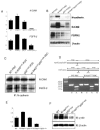N-cadherin and keratinocyte growth factor receptor mediate the functional interplay between Ki-RASG12V and p53V143A in promoting pancreatic cell migration, invasion, and tissue architecture disruption
- PMID: 16705170
- PMCID: PMC1489079
- DOI: 10.1128/MCB.01055-05
N-cadherin and keratinocyte growth factor receptor mediate the functional interplay between Ki-RASG12V and p53V143A in promoting pancreatic cell migration, invasion, and tissue architecture disruption
Abstract
The genetic basis of pancreatic ductal adenocarcinoma, which constitutes the most common type of pancreatic malignancy, involves the sequential activation of oncogenes and inactivation of tumor suppressor genes. Among the pivotal genetic alterations are Ki-RAS oncogene activation and p53 tumor suppressor gene inactivation. We explain that the combination of these genetic events facilitates pancreatic carcinogenesis as revealed in novel three-dimensional cell (spheroid cyst) culture and in vivo subcutaneous and orthotopic xenotransplantation models. N-cadherin, a member of the classic cadherins important in the regulation of cell-cell adhesion, is induced in the presence of Ki-RAS mutation but subsequently downregulated with the acquisition of p53 mutation as revealed by gene microarrays and corroborated by reverse transcription-PCR and Western blotting. N-cadherin modulates the capacity of pancreatic ductal cells to migrate and invade, in part via complex formation with keratinocyte growth factor receptor and neural cell adhesion molecule and in part via interaction with p120-catenin. However, modulation of these complexes by Ki-RAS and p53 leads to enhanced cell migration and invasion. This preferentially induces the downstream effector AKT over mitogen-activated protein kinase to execute changes in cellular behavior. Thus, we are able to define molecules that in part are directly affected by Ki-RAS and p53 during pancreatic ductal carcinogenesis, and this provides a platform for potential new molecularly based therapeutic interventions.
Figures









Similar articles
-
A human cancer xenograft model utilizing normal pancreatic duct epithelial cells conditionally transformed with defined oncogenes.Carcinogenesis. 2014 Aug;35(8):1840-6. doi: 10.1093/carcin/bgu112. Epub 2014 May 24. Carcinogenesis. 2014. PMID: 24858378
-
BRAF and RAS oncogenes regulate Rho GTPase pathways to mediate migration and invasion properties in human colon cancer cells: a comparative study.Mol Cancer. 2011 Sep 23;10:118. doi: 10.1186/1476-4598-10-118. Mol Cancer. 2011. PMID: 21943101 Free PMC article.
-
In vitro modeling of human pancreatic duct epithelial cell transformation defines gene expression changes induced by K-ras oncogenic activation in pancreatic carcinogenesis.Cancer Res. 2005 Jun 15;65(12):5045-53. doi: 10.1158/0008-5472.CAN-04-3208. Cancer Res. 2005. PMID: 15958547
-
[The cooperation between p53 and Ras in tumorigenesis].Yi Chuan. 2012 Dec;34(12):1513-21. doi: 10.3724/sp.j.1005.2012.01513. Yi Chuan. 2012. PMID: 23262097 Review. Chinese.
-
Ductal neoplasia of the pancreas: nosologic, clinicopathologic, and biologic aspects.Semin Radiat Oncol. 2005 Oct;15(4):254-64. doi: 10.1016/j.semradonc.2005.04.001. Semin Radiat Oncol. 2005. PMID: 16183479 Review.
Cited by
-
Detection of Tumor Suppressor Genes in Cancer Development by a Novel shRNA-Based Method.Mol Cancer Res. 2015 May;13(5):863-9. doi: 10.1158/1541-7786.MCR-14-0709. Epub 2015 Feb 27. Mol Cancer Res. 2015. PMID: 25724428 Free PMC article.
-
Epithelial memory of inflammation limits tissue damage while promoting pancreatic tumorigenesis.Science. 2021 Sep 17;373(6561):eabj0486. doi: 10.1126/science.abj0486. Epub 2021 Sep 17. Science. 2021. PMID: 34529467 Free PMC article.
-
Regulation of Epithelial Plasticity Determines Metastatic Organotropism in Pancreatic Cancer.Dev Cell. 2018 Jun 18;45(6):696-711.e8. doi: 10.1016/j.devcel.2018.05.025. Dev Cell. 2018. PMID: 29920275 Free PMC article.
-
N-cadherin-mediated adhesion and signaling from development to disease: lessons from mice.Prog Mol Biol Transl Sci. 2013;116:263-89. doi: 10.1016/B978-0-12-394311-8.00012-1. Prog Mol Biol Transl Sci. 2013. PMID: 23481199 Free PMC article. Review.
-
The diabetes gene Pdx1 regulates the transcriptional network of pancreatic endocrine progenitor cells in mice.J Clin Invest. 2009 Jul;119(7):1888-98. doi: 10.1172/JCI37028. J Clin Invest. 2009. PMID: 19487809 Free PMC article.
References
-
- Agbunag, C., and D. Bar-Sagi. 2004. Oncogenic K-ras drives cell cycle progression and phenotypic conversion of primary pancreatic duct epithelial cells. Cancer Res. 64:5659-5663. - PubMed
-
- Aguirre, A. J., C. Brennan, G. Bailey, R. Sinha, B. Feng, C. Leo, Y. Zhang, J. Zhang, J. D. Gans, N. Bardeesy, C. Cauwels, C. Cordon-Cardo, M. S. Redston, R. A. DePinho, and L. Chin. 2004. High-resolution characterization of the pancreatic adenocarcinoma genome. Proc. Natl. Acad. Sci. USA 101:9067-9072. - PMC - PubMed
-
- Alencar, H., R. King, M. Funovics, C. Stout, R. Weissleder, and U. Mahmood. 2005. A novel mouse model for segmental orthotopic colon cancer. Int. J. Cancer 117:335-339. - PubMed
-
- Almoguera, C., D. Shibata, K. Forrester, J. Martin, N. Arnheim, and M. Perucho. 1988. Most human carcinomas of the exocrine pancreas contain mutant c-K-ras genes. Cell 53:549-554. - PubMed
Publication types
MeSH terms
Substances
Grants and funding
LinkOut - more resources
Full Text Sources
Research Materials
Miscellaneous
